 klaus-michael schneider
klaus-michael schneider
Keywords: education |
Links: FOTW homepage | search | disclaimer and copyright | write us | mirrors

Last modified: 2021-08-26 by  klaus-michael schneider
klaus-michael schneider
Keywords: education |
Links: FOTW homepage |
search |
disclaimer and copyright |
write us |
mirrors
See also:
Other Institutions:
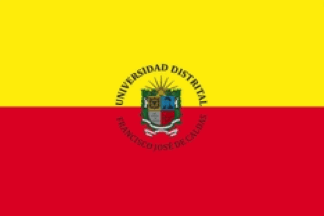 image by Ivan Sache, 07 June 2018
image by Ivan Sache, 07 June 2018
Colegio Municipal de Bogotá, founded by Agreement No. 10 adopted on 5
February 1948 by the Bogotá Council, was upgraded on 6 August 1950 to
Universidad Municipal de Bogotá. Two months later, the rector, Father Daniel de
Cayzedo, registered the Statutes of the university, renamed to Universidad
Municipal de Bogotá Francisco José de Caldas. This was a tribute by the rector
to the martyr of independence Francisco José de Caldas, who, like him, was born
in Popayán.
The naturalist and politician Francisco José de Caldas (1768-1816), aka the Wise
Caldas, supported the independence and was executed by the Royalist troops.
The university adopted its current name in 1955, when Bogotá was made a Special
District. An attempt to transform it into a technological institute, pushed in
1968 by Virgilio Barco, Mayor of Bogotá, was rejected by the educational
community and the student's families.
An internal crisis led to the closure of the university, ordered in May 1979 by
Mayor Hernando Durán Dussán; planned for one month, the closure lasted more than
two years, which caused a decrease in the number of students from 4,000 to 600.
The university is made of 5 Faculties (Arts, Science and Education, Engineering,
Environment and Natural Resources, and Technology) and 4 Institutes. The campus
is composed of 23 sites scattered all over the town of Bogotá.
Source: Official website
The flag of the university is horizontally divided yellow-red, like the flag of
Bogotá, with the addition of the university's coat of arms, surrounded by its
name, for the sake of differentiation from the municipal flag.
The coat of arms of the university, established in 1950 as a seal, experienced
different transformations and variations with time. The Development Plan
initiated in 2013 prescribed the establishment of a graphic charter, which was
eventually adopted by Agreement No. 11, enacted on 23 September 2015 by the
University Higher Council.
The coat of arms is "Quarterly, 1. The arms of Bogotá, 2. Azure a portrait of
Caldas, 3. Argent the motto "UBI VERITAS ... LIBERTAS" sable, 4. Gules a ...
sable. The shield surmounted by a rising sun or. The shield placed on
lambrequins vert. Beneath the shield a scroll argent inscribed "UNIVERSITAS
DISTRITALIS FRANCISCIA JOSEPH CALDAS" sable.
Ivan Sache, 07 June 2018
 image by Ivan Sache, 01 December 2014
image by Ivan Sache, 01 December 2014
Institución Educativa Francisco José de Caldas was established in
Arauca (Arauca Department) by Resolution No. 169 of 2 April 1974.
The institute is named for Francisco José de Caldas (1768-1816), aka
the Wise Caldas. A naturalist and politician, Caldas supported the
independence and was executed by the Royalist troops.
The flag of the institute, designed in 1974 by Luis Villamizar, is
horizontally divided blue-white.
Blue is a symbol of greatness and immensity.
White is a symbol of purity and peace.
Source:
http://www.caldasarauca.edu.co/arauca/institucional/simbolos
- Institute's website
Ivan Sache, 01 December 2014
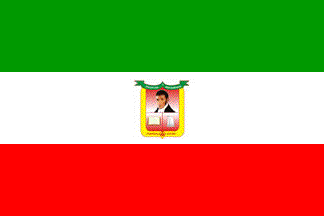 image by Ivan Sache, 11 August 2014
image by Ivan Sache, 11 August 2014
Institución Educativa Francisco José de Caldas was established on 1 August
1970 by Decree No. 284 in Islita borough, part of the municipality of Corozal
(Sucre Department). Then known as Escuela de Islita, the institute was ran by a
Franciscan nun, Sister María Gema García. The Franciscans would subsequently
manage the institute, until the teacher Alba Marina Bertel Alvarez was appointed
director of the institute by Decree No. 55 of 7 March 1994. Due to unhealthy
local conditions, the institute was relocated on 5 August 1994 to the San
Francisco borough. Colegio de Básica La Islita was renamed Colegio Francisco
José de Caldas in 2001 by Resolution No. 1,606. Institución Educativa Francisco
José de Caldas was eventually established by Decree no. 518 of 3 September 2003
as the merger of Colegio Francisco José de Caldas with Colegios Monseñor Carmelo
Percy, Tres de Marzo, Once de Noviembre, Jardín La Josefina, and Unidad Integral
de Educación Especial.
The institute is named for Francisco José de Caldas (1768-1816), aka the Wise
Caldas. A naturalist and politician, Caldas supported the independence and was
executed by the Royalist troops.
The flag of the institute is horizontally divided green-white-red with the
institute's emblem in the middle. Green is a symbol of love for life, respect
for the natural environment, and aspiration to obtain a better educational
environment. White is a symbol of peace and harmony. Red is a symbol of joy and
enthusiasm.
The emblem of the institute is made of a red shield surrounded by a yellow
border and surmounted by a green scroll. The upper half of the shield is charged
with a portrait of Francisco José de Caldas, representing his ideals of wisdom,
liberty, autonomy, dedication, creativity, and production of knowledge. The
lower left and right parts are charged with an open book and a test tube,
respectively, which represent study and scientific research, respectively.
Beneath the shield in the middle of the yellow border are placed five interlaced
rings, representing sports. The green scroll is inscribed with the motto
"DISCIPLINA Y PERTENENCIA" (Discipline and Belonging).
The name of the institute is written in green capital letters above the shield,
this writing being omitted on the flag.
Source:
http://www.inscaldas.edu.co/seccion.asp?idseccion=2&idsubseccion=7 -
Institute's website
Ivan Sache, 11 August 2014
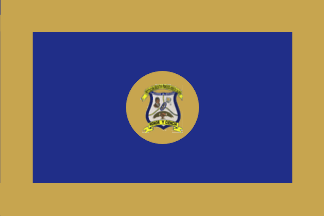 image by Ivan Sache, 14 June 2018
image by Ivan Sache, 14 June 2018
Institución Educativa Francisco José de Caldas is located in Santander de
Quilichao (Caldas Department)
The flag of the institute is blue with a golden border and the institute's coat
of arms placed on a golden disk in the center.
Source: Alex
Garces' website
Ivan Sache, 14 June 2018
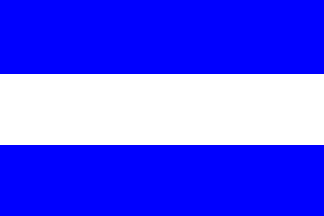 image by Ivan Sache, 26 September 2014
image by Ivan Sache, 26 September 2014
Institución Educativa Francisco José de Caldas, located in Soledad (Atlántico
Department), was established in 1963 in Barranquilla, as Colegio Oficial del
Barrio Abajo. Classes started on 24 April 1964. The institute is named for
Francisco José de Caldas (1768-1816), aka the Wise Caldas. A naturalist and
politician, Caldas supported the independence and was executed by the Royalist
troops.
The flag of the institute is horizontally divided blue-white-blue.
Source: http://caldas.edu.co/ -
Institute's website
Ivan Sache, 26 September 2014
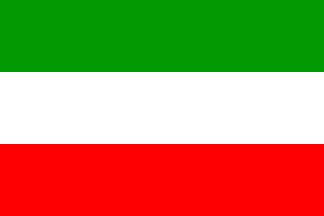 image by Ivan Sache, 21 October 2014
image by Ivan Sache, 21 October 2014
Institución Educativa Departamental Francisco José de Caldas is located in
Villa del Rio borough, part of the municipality of Viotá (Cundinamarca
Department).
The flag of the institute is horizontally divided green-white-red.
Source:
http://laclinicavegetal.blogspot.fr/2011/10/contextualizacion.html -
Institute's blog
Ivan Sache, 21 October 2014
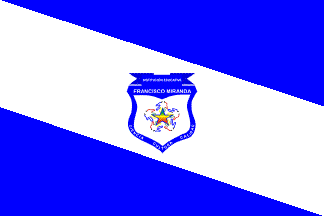 image by Ivan Sache, 20 October 2014
image by Ivan Sache, 20 October 2014
Institución Educativa Francisco Miranda was established in Medellín
(Antioquia Department) by Departmental Resolution No. 16,206 of 27 November
2002, as the merger of Colegio Francisco Miranda and Escuela Julio Arboleda
(est. by Municipal Decree No. 212 of 26 April 1952, as a splinter of Escuela
Carlos Vásquez La Torre). Upon request of its educational community, Escuela El
Bosque, established by Departmental Decree No. 352 of 11 March 1983, was
incorporated to Institución Educativa Francisco Miranda by Municipal Resolution
No. 33 of 21 April 2003.
Escuela Francisco Miranda was first established in 1886 on the today's site of
the Botanical Garden, at the time settled by newcomers who founded several new
boroughs. By Act No. 566 of 25 March 1930, the municipality of Medellín
purchased from Rafael Toro Giraldo a plot to relocate the school. Novena Escuela
de Varones Miranda, inaugurated on 13 September 1931, was eventually recognized
by Departmental Ordinance No. 21 of 28 November 1959. Colegio Francisco Miranda
was established by Departmental Resolution No. 1,313 of 1 October 1997.
The institute is named for the Venezuelan revolutionary Sebastián Francisco de
Miranda y Rodríguez (1750-1816). President of the States of Venezuela for a
short period (1812-1813), Miranda could not fulfill his project of independence
of the Spanish possessions in South America, being, however recognized as the
"Precursor" of the Bolivarian liberation.
The flag of the institute is divided blue-white-blue according to the descending
diagonal, with the institute's emblem in the middle. The blue colour in "King"
shade represents loyalty, confidence, knowledge, intelligence, faith, truth, and
eternal heavens. In heraldry, azure is a symbol of sincerity and piety, being
also a serene colour associated with intelligence and universal conscience.
White is associated with light, kindness, innocence, and purity, being
considered as the colour of perfection. White means peace, security, serenity,
faith, transparency, and purity.
Source:
http://www.franciscomiranda.edu.co/index2.php?id=16029&idmenutipo=2386&tag=
- Institute's website
The emblem of the institute is a shield of traditional heraldic shape, featuring
the institutional colours, King blue and white. The bordure of the shield
represents the source of knowledge. The bordure is inscribed in the lower part
with the motto "CIENCIA CULTURA CALIDAD" (Science Culture Quality), which
summarizes the concepts valued in the institute: Science, as knowledge obtained
through analysis, verification, recapitulation, and development of processes
oriented towards the understanding, the transformation, and the interpretation
of the world; Culture, as the result and process of permanent building of
identity, solidarity, and ways of being and living; and Quality, meaning here
the concept of continuous improvement of the educational process towards
integral education. The upper part of the bordure is inscribed with the name of
the institute.
The shield is charged in the middle with a five-pointed star that historically
represents light proper and is the emblem of "perfection and supreme knowledge",
according to the Pythagoreans. The star further represents human unity, world
peace, universal love, and the natural environment. Here, the star also
represents the five institutional values expressed in the "teleological agenda"
and forming the base of the pedagogic action: respect, supportive commitment,
sense of belonging, honesty, and responsibility. The five points of the stars
are supported by five hands representing in their colours the cultural
integration and the diversity of the educational community, and expressing our
reason for living: teaching and learning. The hands also represent respect for
the different human orientations, being political, social, gender, cultural, and
religious, among other.
Source:
www.franciscomiranda.edu.co/index2.php?id=16027&idmenutipo=2386&tag= -
Institute's website
Escuela Francisco de Miranda used an emblem of similar shape but featuring bees
and a honeycomb and a different motto, "TRABAJO UNION Y CIENCIA" (Work, Union,
and Science).
Source:
http://www.franciscomiranda.edu.co/index2.php?id=16025&idmenutipo=2386&tag=
- Institute's website
Ivan Sache, 20 October 2014
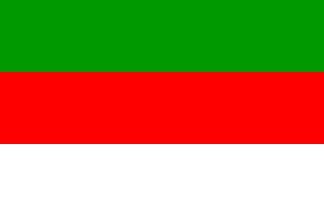 image by Ivan Sache, 17 November 2014
image by Ivan Sache, 17 November 2014
Institución Educativa Técnica Francisco Nuñez Pedroso was established in
Mariquita (Tolima Department) by Decree No. 628 of 16 March 1956. The school is
named for Captain Francisco Nuñez Pedroso, the Spanish conquistador who founded
on 28 August 1551 the town of Mariquita, on land belonging to cacique Marquetá.
The flag of the institute is horizontally divided green-red-white, which
represent hope, fighting spirit, and aspiration to unity and peace,
respectively. Details on the official adoption of the flag have been lost.
Source:
http://www.ietfrancisconp.edu.co/portal/?cat=31 - Institute's website
Ivan Sache, 17 November 2014
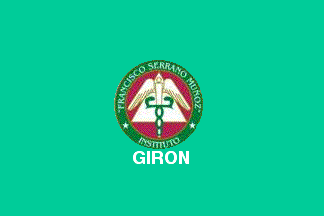 image by Ivan Sache, 20 July 2014
image by Ivan Sache, 20 July 2014
Instituto Francisco Serrano Muñoz is located in Girón (Santander Department). The institute originates in Escuela Las Nieves, founded at the end of the 19th century by a wealthy local family and officially recognized in 1920 as Escuela Urbana de Niñas.
The flag of the institute is green with the institute's emblem in the middle
and the white writing "GIRON" beneath the emblem. Green is a symbol of hope and
glory.
The emblem of the institute features a triangle charged with a
dove, representing peace, and snakes, representing wisdom. The two stars in the
border of the emblem represent the light that guides the educationalists.
http://sededlasnieves.wordpress.com/11-2/ - Escuela Las Nieves' blog
image by Ivan Sache, 20 July 2014
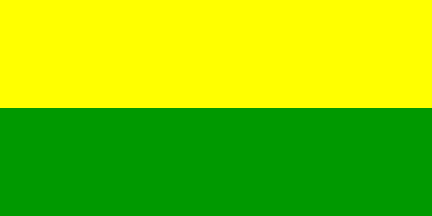 image by Ivan Sache, 5 January 2009
image by Ivan Sache, 5 January 2009
The flag of the Franciscan College Fray Rafael de la Serna is
horizontally divided yellow-green. From the flying flag shown on
<www.frayrafael.edu.co>,
located by Dov Gutterman, the default proportion of the
flag seems to be 1:2.
The college was founded in 1941 in Medellin,
Antioquia and its first name was Instituto Cristobal Colon. By
ministerial order #1610 from 6 June 1953, the college was renamed
as a tribute to the Franciscan friar who founded the University
of Antioquia. Yellow symbolizes the spiritual resources, spirit
and the department of Antioquia. Green
symbolizes the hope in the youth and the exuberant vegetation of
Antioquia. It is said that the dimensions of the flag are
precise, but not what they are indeed.
Ivan Sache, 10 July 2001
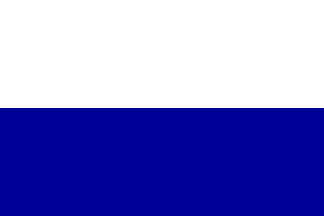 image by Ivan Sache, 13 October 2014
image by Ivan Sache, 13 October 2014
Institución Educativa Fundadores Ramón Bueno y José Triana was established in
Girardot (Cundinamarca Department) by Resolution No. 355 of 30 September 2002,
as the merger of Colegio Municipal, Concentración Urbana República Venezuela
(est. 1944), Concentración Urbana José Antonio Galán (est. 1967), Concentración
Urbana República Argentina, Jardín Infantil Departamental (est. 1972), and
Centro de Educación Especial (est. 1974). The name of the institute was
prescribed by Decree No. 16 of 17 January 2003, as a tribute to the founders
("fundadores") of the town of Girardot. Ramón Bueno and José Triana offered on
10 February 1844 a large plot of land to build buts; the settlement was named
Girardot on 9 October 1852 for Manuel Atanasio Girardot Díaz (1791-1813), a hero
of the struggle for independence who was killed when attempting to hoist the
revolution's flag on the Bárbula hill.
The flag of the institute is horizontally divided white-dark blue. White is a
symbol of purity, light, kindness, innocence, virginity, optimism, and
perfection. Dark blue is a symbol of generosity, health, intelligence, and
tranquility.
Source:
http://www.iefundadoresrbjt.edu.co/portal/wp-content/uploads/2013/08/MANUAL-DE-CONVIVENCIA-IE-FUNDADORES-CONTENIDO.pdf
- Institute's Etiquette Guidebook
Ivan Sache, 13 October 2014